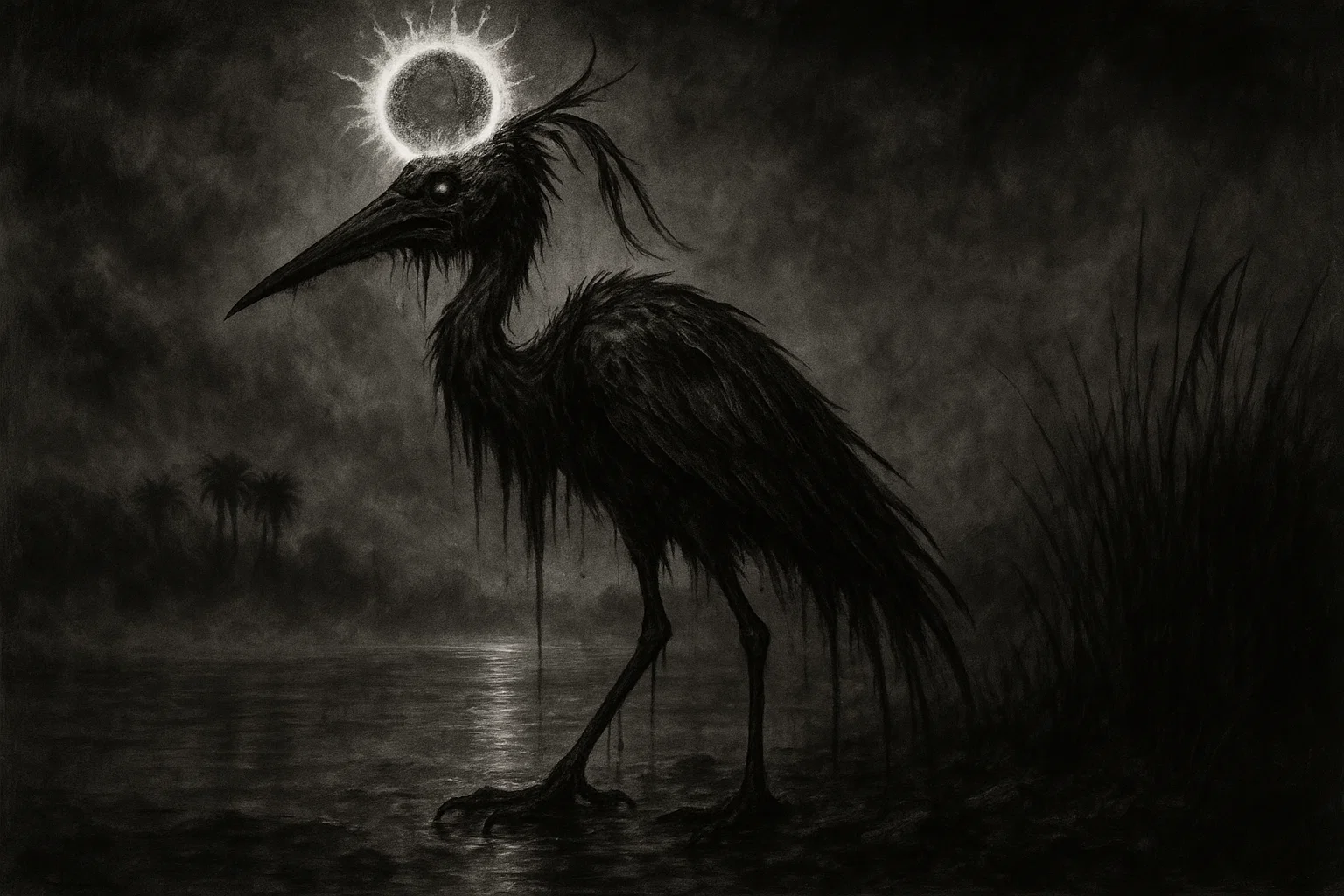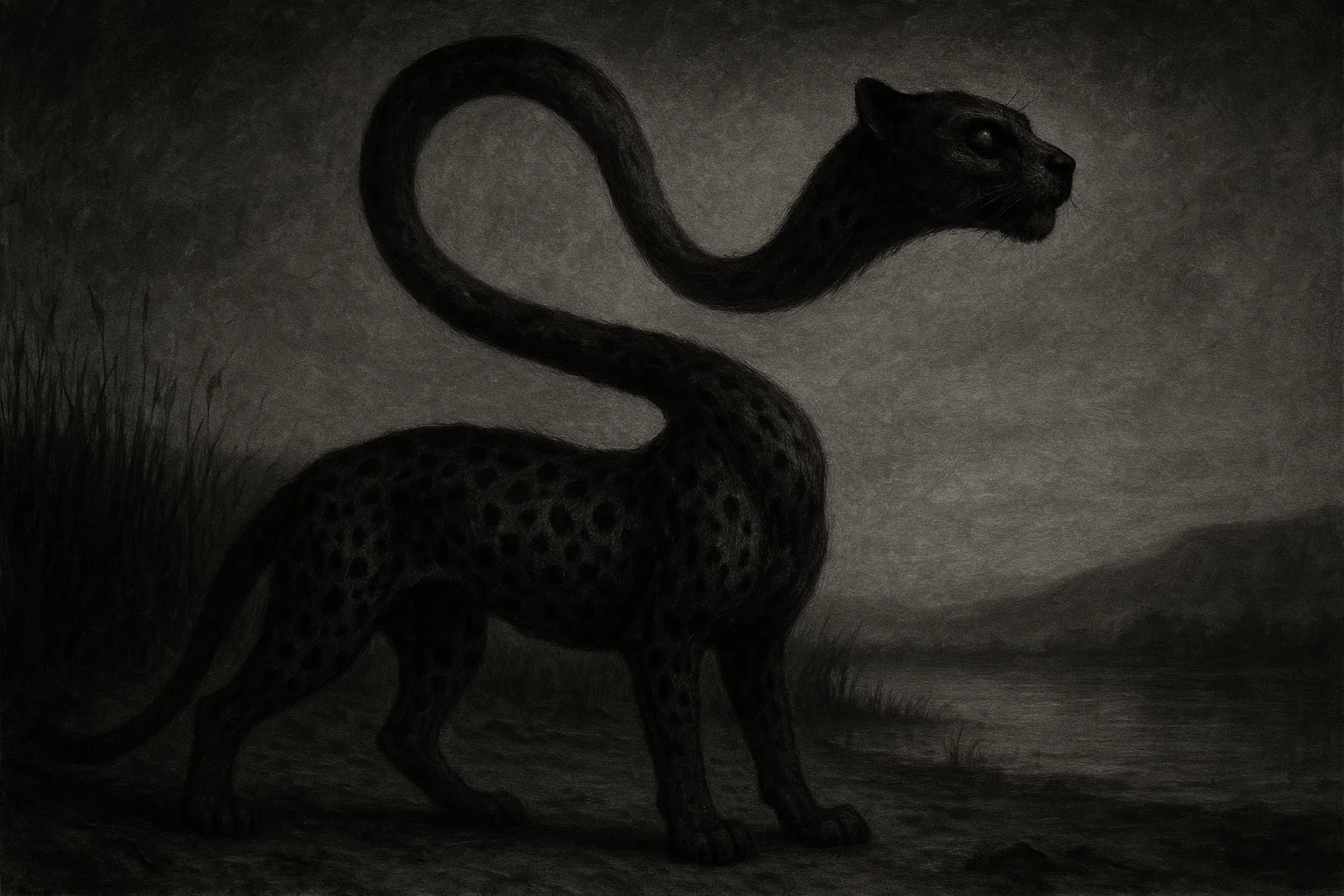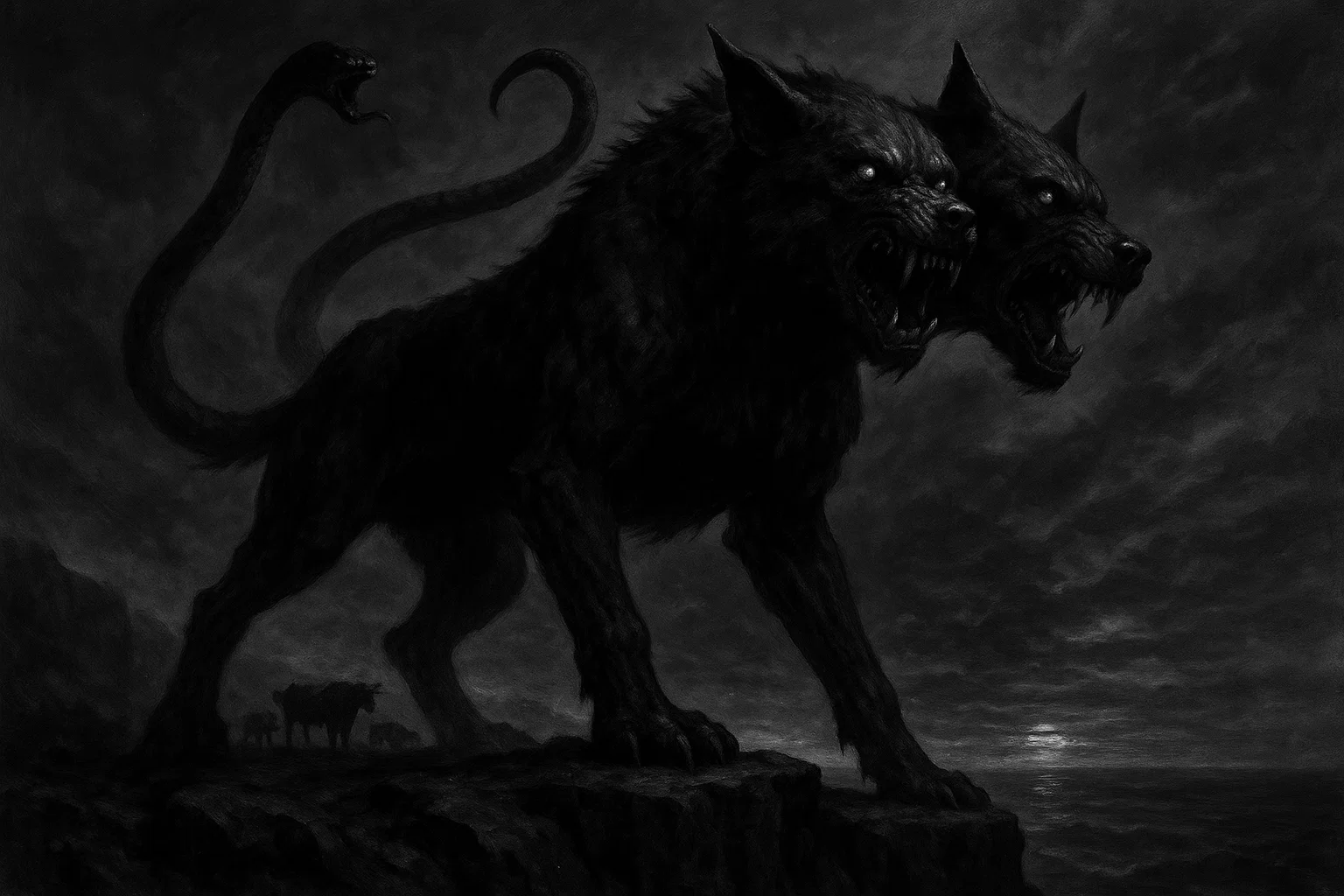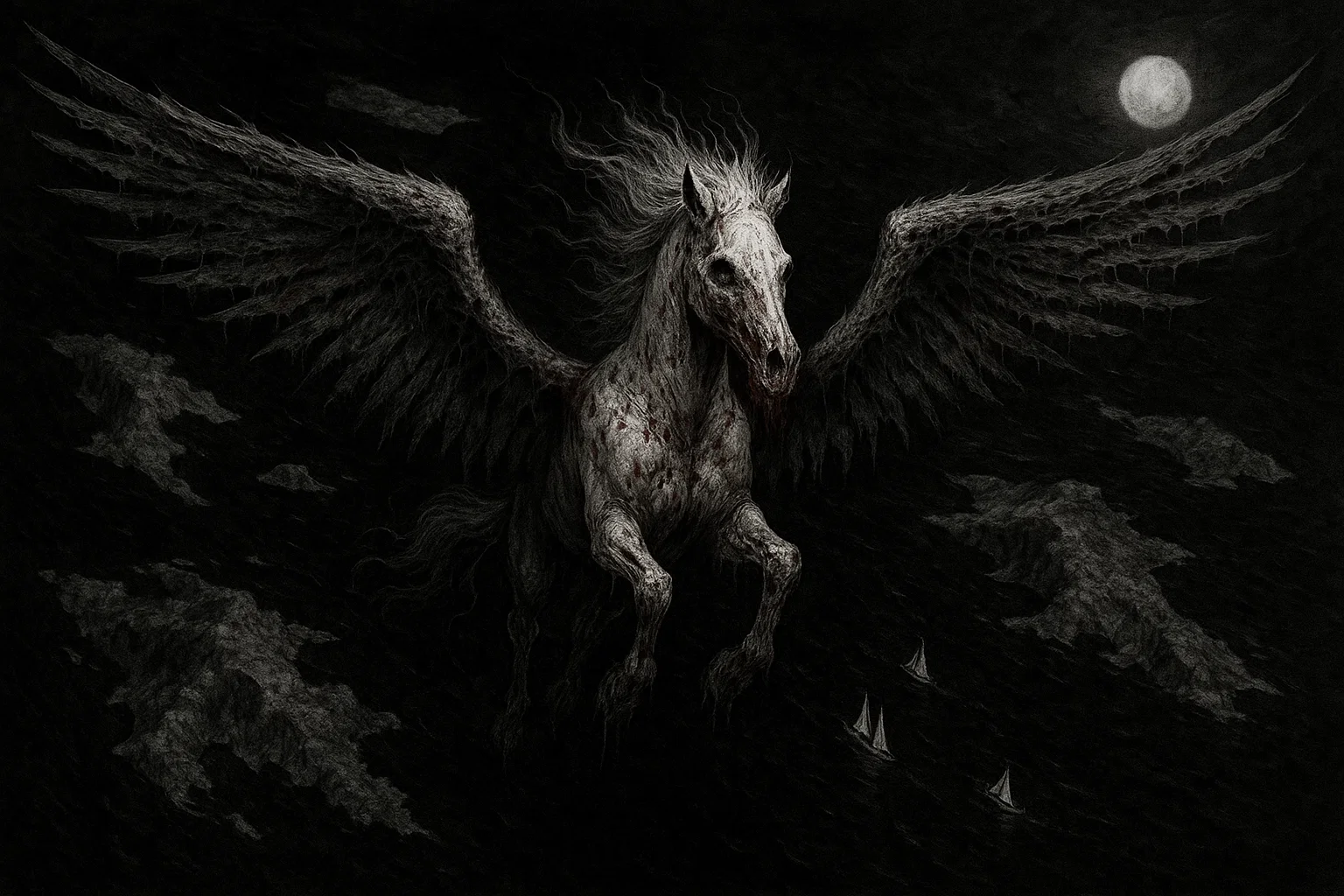Deep within the pristine waters of Okanagan Lake in British Columbia, Canada, lies a mystery that has captivated generations: Ogopogo, the elusive lake monster.
Known to some as a serpentine beast and to others as a sacred spirit, this cryptid has sparked curiosity, debate, and wonder. Is Ogopogo a remnant of a prehistoric era, a misunderstood natural phenomenon, or a product of folklore and imagination?
With roots in the traditions of the syilx/Okanagan people and a history of sightings spanning over a century, the legend of Ogopogo continues to thrive, drawing adventurers, researchers, and skeptics to the shores of one of Canada’s most enigmatic lakes.
Summary
What Is Ogopogo?
Ogopogo, also known as Naitaka or n̓x̌ax̌aitkʷ in the Salish language, is a legendary lake monster believed to inhabit Okanagan Lake in British Columbia, Canada.
The name “Ogopogo” was popularized in 1924 through an English music-hall song performed in Vernon, British Columbia, but the creature’s origins trace back centuries in Indigenous folklore. To the syilx/Okanagan people, n̓x̌ax̌aitkʷ is a sacred spirit of the lake, revered as a protector of the Okanagan Valley and its ecosystem.
It is not a monster but a supernatural entity demanding respect through offerings such as tobacco, sage, or kokanee salmon to ensure safe passage across the lake.
The legend of Ogopogo blends Indigenous spirituality with Western cryptozoology. For the syilx, it is tied to the lake’s natural balance, associated with storms and drownings if disrespected. European settlers, arriving in the early 19th century, misinterpreted these stories, casting Ogopogo as a fearsome beast akin to Scotland’s Loch Ness Monster.
This miscommunication led to its colonial naming and its transformation into a tourism icon, with Ogopogo-themed merchandise, parade floats, and a 15-foot statue on Kelowna’s Waterfront Walk boosting the region’s fame.
Ogopogo’s cultural significance extends beyond folklore. It has appeared in media, including The X-Files, Unsolved Mysteries, Final Fantasy IV, The Venture Bros., and the Yu-Gi-Oh! trading card game, cementing its place in popular culture.
In the 1980s, a local tourism agency offered a $1 million reward for proof of its existence, and Greenpeace listed it as an endangered species, stipulating it must be filmed, not captured.
In 1989, Ogopogo was protected under the BC Wildlife Act, making it illegal to hunt or disturb, reflecting its symbolic importance. Today, it remains a subject of fascination, with Indigenous-led tours by groups like Moccasin Trails emphasizing its spiritual role and museums like the Okanagan Heritage Museum and Sncəwips Heritage Museum working to integrate syilx perspectives into its narrative.
What Does Ogopogo Look Like?
Eyewitness accounts describe Ogopogo as a large, serpentine creature measuring 40 to 50 feet (12 to 15 meters) in length, with a body thicker than a telephone pole.
Its skin is typically smooth and dark, ranging from dark green to black, with some reports noting a shiny, scaly appearance. The creature is often seen with multiple humps rising above the water, moving in vertical undulations propelled by a powerful tail.
Its head is variably described as resembling a horse, snake, or sheep, with some accounts mentioning deer-like antlers in syilx descriptions, emphasizing its spiritual nature. Additional features include flippers or fins, suggesting an aquatic adaptation.
You May Also Like: Lizard Man of Lee County Cryptid: Sightings, Tracks, and Legends
Cryptozoologist Karl Shuker classifies Ogopogo as a “many hump” lake monster, suggesting it may resemble a primitive serpentine whale like the extinct Basilosaurus, which lived 40 million years ago. Other theories propose it could be a surviving plesiosaur, mosasaur, or pliosaur, though these lack supporting fossil evidence in the region.
The syilx describe n̓x̌ax̌aitkʷ as dark-colored with a horse’s head and antlers, aligning with its role as a sacred entity rather than a physical creature.
Ogopogo’s appearance seems partially suited to its environment. The dark coloration could help it blend into the deep, murky waters of Okanagan Lake, and its serpentine form might allow agile movement through underwater caves.
However, its reported size and features, such as antlers or a horse-like head, appear out of place in a freshwater ecosystem, raising questions about whether it is a misidentified animal, a cultural symbol, or something unknown.
Habitat: The Depths of Okanagan Lake
Ogopogo is primarily associated with Okanagan Lake, a vast freshwater fjord lake stretching 127.1 kilometers (79.0 miles) with a maximum depth of 232.3 meters (762 feet) and an average depth of 75.9 meters (249 feet).
One of five interconnected lakes in the Okanagan Valley, it has frozen over only eight times in the past 110 years, providing a stable environment for aquatic life. Indigenous lore suggests Ogopogo resides in underwater caves near Rattlesnake Island (also called Monster Island) or Squally Point, areas steeped in spiritual significance where the syilx made offerings for safe passage.
The lake’s ecosystem supports species like kokanee salmon, believed to be part of Ogopogo’s diet, and its connection to lakes like Skaha Lake and Kalamalka Lake may explain occasional sightings in these areas.
The surrounding terrain includes dense forests, rocky shores, and human settlements like Kelowna, Vernon, and Penticton, blending wilderness with urban activity. The lake’s depth and cave systems offer potential hiding spots for an elusive creature, fueling speculation about its existence.
The Okanagan Valley’s geological history, formed by glacial activity, supports a diverse ecosystem but lacks fossil evidence of large aquatic reptiles, challenging theories of Ogopogo as a prehistoric survivor.
The region has a rich history of paranormal events and local legends. The syilx have long told stories of n̓x̌ax̌aitkʷ, associated with storms and drownings, part of a broader tradition of water spirits in Indigenous cultures.
European settlers introduced tales of sea serpents and lake monsters, merging with Indigenous stories to shape the modern Ogopogo legend. Other unexplained phenomena in the area include mysterious lights in the sky, reported near Kelowna, and strange noises from the lake, often attributed to natural causes but adding to the region’s mystique.
While not directly linked to Ogopogo, these events contribute to the Okanagan Valley’s reputation as a hotspot for paranormal activity.
No other cryptids are prominently reported in Okanagan Lake, but the nearby Cadborosaurus, a marine cryptid off British Columbia’s coast, shares similar serpentine traits.
Ogopogo Sightings: A Century of Encounters
Sightings of Ogopogo date back to the 19th century, with over 100 reported encounters from Indigenous peoples and settlers:
| Date | Location | Witness(es) | Description |
|---|---|---|---|
| 1855 | Okanagan Lake | John McDougall | Horses pulled underwater; early Indigenous account. |
| 1872 | Okanagan Lake | Susan Allison | Dinosaur-like creature; first non-Indigenous sighting. |
| 1890 | Okanagan Lake | Thomas Shorts | 16 ft snake with ram’s head; reported in newspapers. |
| 1926 | Okanagan Mission beach | ~30 cars of witnesses | Serpentine humps; mass sighting. |
| 1968 | Okanagan Lake | Art Folden | Filmed large wake; analyzed as solid object. |
| 1978 | Okanagan Lake bridge | Bill Steciuk, ~20 others | Head with three black humps; 50 m away. |
| 1980 | Kelowna beach | 50 tourists, Larry Thal | Creature observed for 45 min; 10 sec on film. |
| 1989 | Okanagan Lake | John Kirk | 10.7–12.2 m creature with 5 humps; 40 km/h. |
| 1989 | Bear Creek | Ken Chaplin, Clem | 15 ft creature; possibly beaver. |
| 1992 | Okanagan Lake | Paul Demara | Videotaped creature moving at 8 km/h. |
| 2000 | Rattlesnake Island | Japanese expedition | 40 ft sonar image; underwater caves found. |
| 2001 | Okanagan Lake | Unknown | Inconclusive sonar readings of large object. |
| 2006 | Okanagan Lake | Unknown | Additional underwater caves discovered. |
| 2008 | Okanagan Lake | Sean Viloria, Jessica Weagers | Photographed 5.5–6 m creature; no tampering evidence. |
| 2009 | Okanagan Lake | Bill Steciuk expedition | Thermal imaging showed 40–50 ft heat trails; found sinkholes, carcass. |
| 2011 | Okanagan Lake | Unknown | Cell phone video of two dark shapes; likely logs. |
| 2018 | Bluebird Bay | Andrew | Large wake photographed; possible 15 m snake. |
| 2019 | Bear Creek Park | Jim La Rocque | Serpentine creature with seven fins; filmed. |
| 2022 | Near Kelowna | Benedict Hanchar, Colleen, Myrna Germaine Brown | Dragon-like object; photographed. |
| 2024 | Okanagan Lake | Unknown | Odd waves filmed; possible Ogopogo sighting. |
1926: Mass Sighting at Okanagan Mission Beach
Date: Summer 1926
Location: Okanagan Mission beach, Okanagan Lake
Witnesses: Approximately 30 cars of onlookers
Description: One of the most credible mass sightings occurred when dozens of people, gathered near Okanagan Mission beach, observed serpentine humps rising from the lake’s surface. The witnesses, including families and tourists, reported seeing a long, dark creature with multiple humps moving steadily through the water, approximately 100 meters offshore.
You May Also Like: The Pickens County Courthouse Haunting: Is the Face Real?
The sighting lasted several minutes, allowing many to corroborate the details. Local newspapers covered the event, noting the excitement and speculation it sparked. The sheer number of witnesses and the consistency of their descriptions make this sighting a cornerstone of Ogopogo lore, though skeptics suggest it could have been a group of otters or a boating wake.
1968: Art Folden’s Filmed Sighting
Date: August 1968
Location: Okanagan Lake, near Peachland
Witnesses: Art Folden and family
Description: Art Folden, a local resident, captured one of the earliest filmed sightings of Ogopogo while driving along Highway 97. Spotting an unusual disturbance in the water, he stopped and used his 8 mm camera to record a large wake caused by a submerged object, approximately 100 meters from shore.
The footage, later analyzed by experts, showed a solid, three-dimensional object moving at a steady pace, estimated to be 15–20 meters long. The Folden family described the object as dark and serpentine, with no visible head or fins.
The film gained attention on shows like Unsolved Mysteries, but skeptics argue it could depict waterfowl, otters, or a log. Despite the ambiguity, the footage remains a key piece of visual evidence.
1980: Kelowna Beach Tourist Sighting
Date: July 1980
Location: Kelowna beach, Okanagan Lake
Witnesses: Approximately 50 tourists, including Larry Thal
Description: A group of around 50 tourists gathered on Kelowna beach witnessed a remarkable 45-minute sighting of a creature in Okanagan Lake. The group observed multiple humps and a long, dark body moving through the water, approximately 50–100 meters from shore.
Larry Thal, a visitor, captured 10 seconds of 8 mm film showing a serpentine form, though the footage is grainy and inconclusive. Witnesses described the creature as 10–15 meters long, with a head resembling a horse or snake.
The sighting was widely reported in local media and featured on In Search Of, highlighting its significance. Skeptics suggest the group may have seen otters swimming in a line, but the duration and number of witnesses add credibility to the account.
2000: Japanese Expedition Sonar Sighting
Date: Summer 2000
Location: Near Rattlesnake Island, Okanagan Lake
Witnesses: Japanese expedition team
Description: A Japanese research team, equipped with sonar technology, conducted an expedition to investigate Ogopogo near Rattlesnake Island, a site long associated with the creature in syilx lore. The team detected a 40-foot-long object approximately 7 meters below the surface, which appeared to move independently of currents.
You May Also Like: The Cursed Noh Mask | Horror Story
The sonar image suggested a large, elongated form, consistent with eyewitness descriptions. Additionally, the expedition discovered underwater caves in the area, supporting theories that Ogopogo could hide in such structures. The findings were reported in international media, sparking renewed interest in the cryptid.
While the sonar image is compelling, it lacks visual confirmation, and some suggest the object could have been a large fish or debris. The expedition’s scientific approach makes this sighting notable.
2008: Viloria and Weagers Photograph
Date: August 2008
Location: Okanagan Lake, near Kelowna
Witnesses: Sean Viloria and Jessica Weagers
Description: Sean Viloria and Jessica Weagers, two local residents, were boating on Okanagan Lake when they spotted an unusual object in the water. Using a digital camera, they captured a photograph of a 5.5–6-meter-long creature with a dark, serpentine body and multiple humps, approximately 30 meters from their boat.
The image, analyzed by experts, showed no signs of tampering and was featured on MonsterQuest. The witnesses described the creature as moving smoothly, with a head resembling a snake. The photograph’s clarity and the credibility of the witnesses make this one of the most significant modern sightings.
Skeptics propose it could depict a group of otters or a wave formation, but the image remains a focal point of Ogopogo research.
Evidence and Investigations
Physical evidence for Ogopogo is scarce and often inconclusive, limited to photographs, videos, sonar images, and a recent carcass.
Physical Evidence
Photographs and Videos: The 1968 Folden Film shows a large wake, analyzed as a solid object but possibly waterfowl or otters. The 2008 Viloria photograph depicts a 5.5–6 m creature, with no tampering evidence, featured on MonsterQuest. The 2011 cell phone video shows two dark shapes, likely logs. A 2018 video by Blake Neudorf, posted on Cryptid Lab, shows a creature moving across the lake, considered among the clearest evidence but still debated. The 2019 La Rocque video shows a serpentine form with fins.
Sonar Images: The 2000 Japanese expedition detected a 40 ft object 7 meters below near Rattlesnake Island, accompanied by evidence of underwater caves. Inconclusive sonar readings in 2001 and cave discoveries in 2006 add intrigue but lack confirmation.
Carcass: In 2023, Dan Poppoff found a 1-meter-long carcass near Lakeshore Road, currently awaiting DNA testing in Ontario, with further examination planned in Alberta. An earlier find in the late 1800s, a vertebrate bone thought to be from a whale, went missing from a museum, leaving its origin unresolved.
Other Traces: No footprints, scales, or other physical traces have been conclusively linked to Ogopogo, limiting tangible evidence.
You May Also Like: Caipora Sightings Across Brazil: Myth, Cryptid, or Forest Ghost?
Scientific Explanations
Scientists offer several explanations for Ogopogo sightings, supported by research and environmental analysis:
- Misidentifications: Otters, swimming in rows, can create a serpentine illusion, as suggested by skeptics like Benjamin Radford for John Kirk’s 1989 sighting. Beavers, waterfowl, or floating logs are common culprits, especially in turbulent waters. Waterspouts, frequent on Okanagan Lake, may inspire myths.
- Sturgeon Theory: White sturgeon, native to connected rivers, can grow to 6 meters but are rare in Okanagan Lake due to dams. Their bottom-feeding behavior makes surface sightings unlikely, and a $10,000 reward for sturgeon evidence remains unclaimed. The theory is plausible but lacks direct evidence.
- Thermal Stratification: The “Ogopogo wave,” caused by temperature differences in the lake, creates illusions of movement, as explained by Robert Young, a UBC Okanagan professor. This phenomenon aligns with sightings of unusual wakes without visible boats.
- Prehistoric Survivor: Cryptozoologists propose Ogopogo could be a plesiosaur, mosasaur, or basilosaurus, but the absence of regional fossils undermines this theory. The lake’s glacial formation 10,000 years ago further reduces the likelihood of a surviving prehistoric species.
- Boating Wakes: The lake’s structure allows wakes to travel long distances, leading observers to mistake them for a creature.
Each explanation has merits and limitations. Misidentifications and natural phenomena account for many sightings, but the consistency of reports, especially mass sightings, suggests an unresolved mystery.
The 2009 Steciuk expedition used thermal imaging and divers to explore sinkholes, finding a kokanee salmon carcass but no definitive proof. The 2024 documentary Cursed Waters: Creature of Lake Okanagan by Small Town Monsters investigates these theories, emphasizing the human element of belief in Ogopogo.
Comparison With Other Similar Cryptids
Ogopogo is part of a global phenomenon of lake monsters, sharing traits with cryptids in similar environments:
| Cryptid | Location | Description | Similarities to Ogopogo | Differences from Ogopogo |
|---|---|---|---|---|
| Nessie | Loch Ness, Scotland | Hump-backed, plesiosaur-like, 20-40 ft | Serpentine body, freshwater lake habitat | Global fame, colder climate, deeper loch |
| Champ | Lake Champlain, USA/Canada | Serpentine, 18-100 ft, humps | North American lake monster, similar size | Shallower lake, cross-border sightings |
| Manipogo | Lake Manitoba, Canada | Serpentine, 12-50 ft, humps | Canadian lake monster, freshwater habitat | Larger, shallower lake, fewer sightings |
| Memphre | Lake Memphremagog, USA/Canada | Serpentine, 20-40 ft, dark-colored | Cross-border lake monster, similar form | Different ecology, less cultural prominence |
| Bessie | Lake Erie, USA/Canada | Serpentine, 30-40 ft, snake-like | Great Lakes cryptid, serpentine form | Larger, deeper lake, urbanized region |
| Caddy | Cadboro Bay, BC, Canada | Serpentine, 30-60 ft, humps | BC location, similar serpentine description | Marine habitat, coastal sightings |
| Igopogo | Lake Simcoe, Ontario, Canada | Serpentine, 12-70 ft, humps | Canadian lake monster, freshwater habitat | Smaller lake, different province |
| Nahuelito | Lake Nahuel Huapi, Argentina | Serpentine, 15-150 ft, humps | Similar serpentine form, lake habitat | South American ecosystem, volcanic lake |
| Storsjöodjuret | Lake Storsjön, Sweden | Serpentine, 10-45 ft, humps | Multiple humps, freshwater lake | European lake, colder climate |
| Sharlie | Payette Lake, Idaho, USA | Serpentine, 25-50 ft, dark-colored | North American, similar size and form | Smaller lake, different regional folklore |
| Mokele-Mbembe | Congo River Basin, Africa | Sauropod-like, 15-30 ft, aquatic | Large aquatic cryptid, elusive nature | Riverine habitat, dinosaur-like form |
| Kusshii | Lake Kussharo, Japan | Serpentine, 30-60 ft, humps | Lake monster, similar serpentine form | Volcanic lake, Asian cultural context |
Is Ogopogo Real?
The existence of Ogopogo remains unproven, with no definitive evidence confirming it as a distinct species. The lake’s depth and cave systems offer potential hiding spots, but the lack of clear physical evidence—beyond disputed photos, videos, and sonar images—leans toward skeptical explanations.
Scientists favor misidentifications or natural phenomena, yet the consistency of sightings and cultural significance keep the mystery alive.
For the syilx, Ogopogo’s reality is spiritual, embodying the lake’s sacred essence through n̓x̌ax̌aitkʷ. Its role in tourism, with a $1 million reward offered in the 1980s and its status under the BC Wildlife Act, underscores its economic and cultural impact.
Whether a creature, a myth, or an illusion, Ogopogo continues to inspire wonder, reminding us that some mysteries endure beyond scientific resolution.







